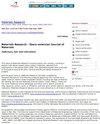Applying ANOVA to Study the Effect of Weight Factions of the Nano-Hafnia Dispersed in Spin Coated Gelatin on the Corrosion Behaviour of AISI 316L Steel
IF 1.3
4区 材料科学
Q4 MATERIALS SCIENCE, MULTIDISCIPLINARY
Materials Research-ibero-american Journal of Materials
Pub Date : 2023-01-01
DOI:10.1590/1980-5373-mr-2023-0127
引用次数: 0
Abstract
This study aims to examine the potential improvement of uniform corrosion resistance and critical pitting potential of AISI 316L stainless steel (SS) in a simulated marine environment containing 3.5 wt. % NaCl by applying layer of gelatin containing HfO2 nanoparticles using spin coating. Also, to examine the statistical significance of using different weight fractions of HfO2 in the applied layer on the corrosion protection performance. The corrosion performance was assessed from potentiodynamic polarization. X-ray diffraction (XRD) was used to check the presence of HfO2 in gelatin matrix. Scanning electron microscopy (SEM), and energy dispersive X-ray analysis (EDX) were used to examine the surface morphology and elemental composition of corrosion products. The results showed that the applied nanocomposite coatings enhanced both uniform and localized corrosion resistance of the underlying AISI 316L SS, also Analysis of Variance (ANOVA) test approved that the weight fractions of dispersed HfO2 nanoparticles have a statistical significant effect on the corrosion performance. Nanocomposites coating having 2 wt.% of HfO2 showed the best performance as compared to other examined coatings.应用方差分析研究了分散在自旋包覆明胶中的纳米铪的重量配比对AISI 316L钢腐蚀行为的影响
本研究旨在研究在含3.5 wt. % NaCl的模拟海洋环境中,通过自旋涂层涂覆含有HfO2纳米颗粒的明胶层,对AISI 316L不锈钢(SS)的均匀耐蚀性和临界点蚀电位的改善潜力。同时,检验在涂敷层中使用不同重量分数的HfO2对防腐性能的统计学意义。用动电位极化法评价了腐蚀性能。采用x射线衍射(XRD)检测明胶基质中HfO2的存在。利用扫描电子显微镜(SEM)和能量色散x射线分析(EDX)对腐蚀产物的表面形貌和元素组成进行了研究。结果表明,纳米复合涂层增强了AISI 316L SS的均匀耐蚀性和局部耐蚀性,方差分析(ANOVA)表明,分散的HfO2纳米颗粒的重量分数对腐蚀性能有显著的影响。与其他涂层相比,含2 wt.% HfO2的纳米复合涂层表现出最好的性能。
本文章由计算机程序翻译,如有差异,请以英文原文为准。
求助全文
约1分钟内获得全文
求助全文
来源期刊

Materials Research-ibero-american Journal of Materials
MATERIALS SCIENCE, MULTIDISCIPLINARY-
CiteScore
2.40
自引率
11.80%
发文量
161
审稿时长
3 months
期刊介绍:
Information not localized
 求助内容:
求助内容: 应助结果提醒方式:
应助结果提醒方式:


